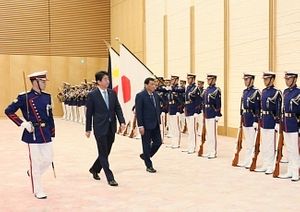Last week, the Philippines commissioned the last two of ten patrol vessels that it had been receiving from Japan. Though the development was part of an ongoing induction process that has been underway since 2016, it nonetheless once again highlighted the ongoing collaboration between the two countries in the maritime security domain.
As I have noted before in these pages, Japan-Philippines defense ties have continued strengthening despite the uncertainties and subsequent refocusing that we have seen under President Rodrigo Duterte (See: “Japan-Philippines Defense Relations Under Duterte: Full Steam Ahead?”). The strategic rationale for both sides remains clear in terms of bilateral ties and their wider interests, with Japan looking to boost ties with Southeast Asian states, including in the defense realm, and the Philippines eyeing ways to strengthen its limited military capabilities to address a series of threats ranging from terrorism to the South China Sea.
Japan-Philippines defense cooperation has been growing over the years across various aspects, including not just defense equipment and transfer, but also critical capacity-building and broader regional cooperation in areas ranging from cybersecurity to maritime security. One of the manifestations of this was when, as part of the Maritime Safety Capability Improvement Project, the Philippines was set to receive ten Parola-class Multi-Role Response Vessels (MRRVs), with the project awarded to the Japan Marine United Corporation (JMUC) in 2015 and implemented as an official development assistance (ODA) project worth 8.8 billion pesos.
The Philippine Coast Guard (PCG) had indicated that the MRRVs, which are 44 meters in length, have a standard cruising speed of 15 knots, and a range of 300 nautical miles, would be used for the PCG for a variety of purposes once they were delivered, including search and rescue operations, assistance in marine environment protection, law enforcement, relief, and transport. It would also fill some longtime gaps for Manila which faces a wide range of maritime security challenges (See: “Where is the Philippines Coast Guard in its Military Modernization?”).
Since the deal was originally set up, the delivery of the vessels itself had proceeded as scheduled every quarter or so, and commissioning had begun in October 2016 and had taken place over time. The seventh and eighth vessels, named BRP Cape San Agustin and BRP Cabra and assigned pennants number 4408 and 4409, were commissioned in March at the PCG National Headquarters in South Harbor, Manila Bay.
Last week, this aspect of Japan-Philippine ties was in the spotlight again as the Philippine Coast Guard commissioned the two final Parola-class patrol vessels. The two ships, which have been named BRP Bagacay and BRP Cape Engaño and assigned pennant numbers 4410 and 4411 respectively, were officially commissioned on August 23.
The commissioning of the final two vessels effectively represents the end of a two-year commissioning process for the whole class of new vessels. It is also yet another step forward for the PCG in this regard, which had indicated that it had wanted to be able to fully operate all of the vessels by the end of 2018 or early 2019 to full current maritime gaps and address some of the challenges that the Philippines faces in that domain.

































